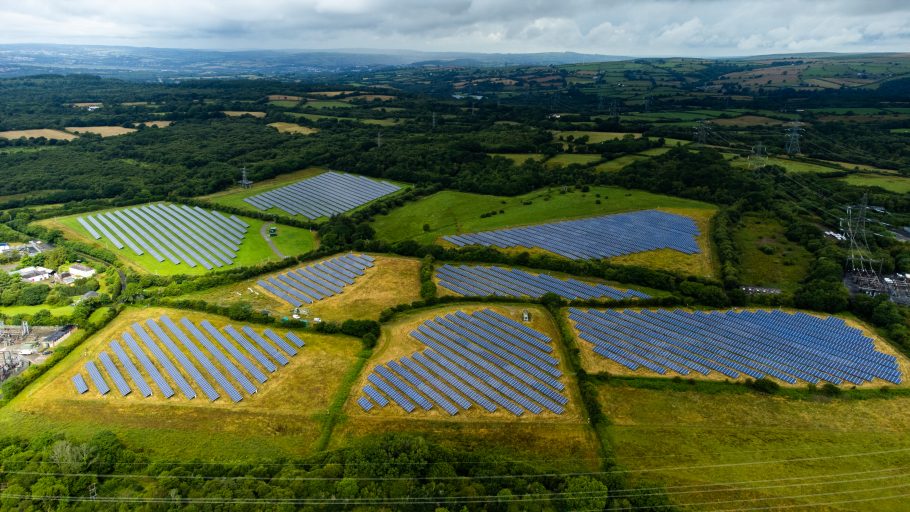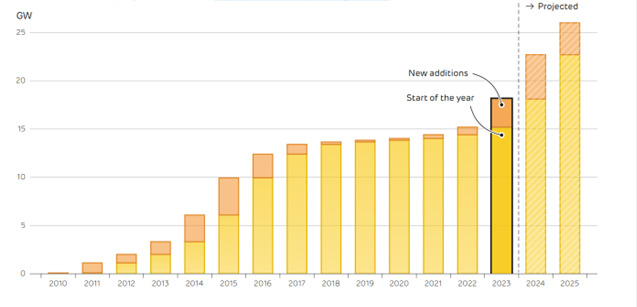
The rate of new solar panel installations in Britain has more than tripled in the last year, according to Drax’s ‘Electric Insights’ quarterly report for Q3 (July to September).
Citing predictions for Rystad Energy, the report noted that 2.9GW of both domestic and utility-scale solar had been installed between 2022 and September 2023, bringing Britain’s total to 18.1GW.
This signifies massive growth in solar PV installation rates compared to the 0.9GW added between 2021 and 2022.
This means 2023 is set to see more solar photovoltaic (PV) capacity installed than in the past six years put together.
And this growth is set to continue, as the electric services company reveals that Britain is forecast to install 4.6GW of solar capacity in 2024.

However, as solar capacity grows, wholesale power prices will plummet due to the technology not being centrally dispatchable – meaning that solar will continue to export to the grid regardless of demand.
This is a particular concern during periods of lower demand such as summer, for example, the ten sunniest days in Q3 saw net demand hit a minimum of 18.9GW, typically at 2pm revealed Drax.
To help combat this, the company called for greater interconnection with neighbouring countries, as well as highlighting the need for long-duration storage.
Q3 2023 Britain’s lowest-carbon quarter on record
Drax’s ‘Electric Insights’ quarterly report also revealed that Q3 this year was the lowest-carbon quarter on record in Britain, with emissions falling to 143g/kWh.
According to the electric services company, this is the first time that the 150g/kWh milestone has been beaten over a quarter.
Before this, the UK’s carbon intensity had remained stagnant since 2020, hovering close to 180g/kWh.
Figure 1: Quarterly average carbon intensity of electricity generation over the last decade, log scale

1GW of demand disappears
Electricity demand in Q3 fell by 5% this year, hitting a new low for the quarter and dropping below 60TWh to 59.1TWh.
This represents a fall in demand of over 1GW since last year.
Figure 2: Weekly average electricity demand over Quarter 3 this year, last year, and over the preceding decade

Drax attributed this drop partly to mild weather, including a lack of heat waves in July and August, and a warm September.
But the biggest impact on demand noted by Drax was high power prices, forcing consumers to cut back on electricity use. National Energy Action (NEA) recently revealed results of a poll which showed that struggling households were resorting to extreme coping tactics to save on their energy bills, including putting newspaper on their windows.
“This is a milestone moment in the UK’s decarbonisation journey, getting our carbon emissions down by more than two-thirds in just a decade is a real achievement,” said Dr Iain Staffell of Imperial College London, and lead author of the quarterly Drax Electric Insights report series.
“With our renewable capacity continuing to grow, we should see more clean power records broken in the coming years. However, the long-term picture is more complicated, and it is vital that government continues to explore how to unlock investment in clean energy technologies.
“The rise in electric vehicles and heat pumps will push up electricity demand. We need to build more renewables of all types and kick-start negative emissions technologies, to not just keep pace with demand growth, but continue growing the share of clean energy and keep carbon emissions falling.”
Part of this article was taken from our sister site Current±, the full article can be read here.

